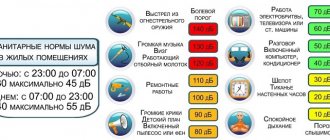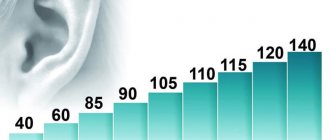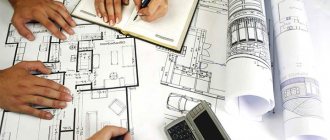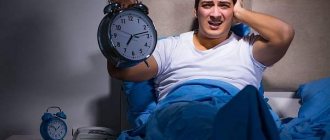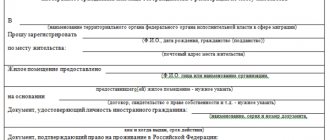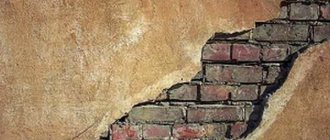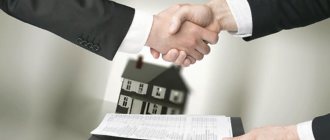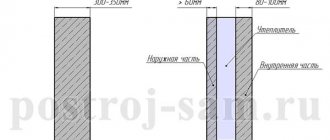The permissible noise level in various circumstances is regulated by the rules of SanPiN 2.1.2.2645-10 “Sanitary and epidemiological requirements for living conditions in residential buildings and premises.” Standards for residential premises establish an acceptable noise level of no more than 45 decibels at night, and 55 decibels during the day.
The legislation establishes that night time lasts from 23:00 to 07:00, the rest of the time is daytime.
Equivalent and maximum sound levels during daytime and nighttime
According to clause 6.3 of SN 2.2.4/2.1.8.562-96, permissible values of sound pressure levels in octave frequency bands, equivalent and maximum sound levels of penetrating noise in residential and public buildings and noise in residential areas should be taken according to Table 3 (Appendix to SN), according to which in the living rooms of apartments the equivalent and maximum sound levels are:
- from 23.00 to 7.00 hours (at night) should not exceed 30 and 45 dBA;
- from 7:00 to 23:00 hours (daytime) should not exceed 40 and 55 dBA.
Similar indicators of acceptable sound pressure levels are specified in Appendix No. 3 to SanPiN 2.1.2.2645-10, approved by Resolution of the Chief State Sanitary Doctor of the Russian Federation dated June 10, 2010 No. 64
How much does it cost to measure?
In a situation where the measurement is carried out as part of a court hearing, all costs of the examination are subsequently borne by the losing party.
The situation is different in situations where a citizen, on his own initiative, writes an application to the authorized bodies to call a specialist and check the noise level.
Prices vary significantly in different regions. Let's take Moscow as an example. Here, the measurement price includes several elements:
- Departure of a specialist.
- Drawing up the protocol.
- Drawing up a conclusion for the court.
In total, a specialist visit will cost a citizen thirty thousand rubles. This cost may be increased when a specialist visits on weekends or holidays.
In regions remote from Moscow, the cost of measurement can be significantly lower.
Maximum sound level in the apartment day and night: 55 and 45 dBA
The maximum permissible sound levels in apartment rooms are also indicated in the Decree of the Government of the Russian Federation of January 28, 2006 N 47 “On approval of the Regulations on recognizing premises as residential premises, residential premises unsuitable for habitation and an apartment building as unsafe and subject to demolition or reconstruction”, in paragraph 26 which is indicated:
In a residential building, permissible sound pressure levels in octave frequency bands, equivalent and maximum sound and penetrating noise levels must correspond to the values established in current regulatory legal acts, and not exceed the maximum permissible sound level in rooms and apartments during the daytime of 55 dB, in night - 45 dB. At the same time, the permissible noise levels created in residential premises by ventilation systems and other engineering and technological equipment must be 5 dBA lower than the specified levels during the day and night.
Repair work
A separate item is carrying out repair work. This is much more disturbing than loud music or television, so there is a separate set of rules in the law regarding this issue. Violation of these rules can lead not only to a fine, but also to serious liability. Therefore, follow these rules to avoid ending up in an unpleasant situation:
- Do not carry out repairs or construction work on weekends and holidays;
- Construction work can begin no earlier than 9 a.m. and finish no later than 11 a.m.;
- The average repair duration cannot be more than six hours. In this case, it is necessary to take a break for at least an hour;
- The tools used should not create noise exceeding 40 decibels;
- Construction cannot last more than three months. Otherwise, you will need to obtain special permission from the authorities;
- Before remodeling an apartment, you will need to obtain permits;
- Construction waste should not be located in public areas, nor should it block exits for other citizens.
It is best if you warn your neighbors about the renovation and discuss this issue so that they do not have to conduct a noise level inspection and start proceedings with you.
When is the permissible sound pressure level below 30 dBA? – 5 dBA
Sound pressure levels in octave frequency bands in dB, sound levels and equivalent sound levels in dBA for noise generated in rooms and areas adjacent to buildings by air conditioning systems, air heating and ventilation systems and other engineering and technological equipment of the building itself should be accepted 5 dBA lower (amendment = minus (-) 5 dBA) specified in Appendix 3 to these sanitary rules (the amendment for tonal and impulse noise in this case should not be accepted) (clause 6.1.3. SanPiN 2.1.2.2645-10 ).
For example, a measurement is made (at night) of the noise level created by the operation of an elevator, or by a ventilation, air conditioning, heating system, etc. The sound level meter showed a value of 29 dBA equivalent sound level (with an allowable 30 dBA, according to Appendix 3 to SanPiN 2.1.2.2645-10). Excess or not?
Based on the provisions of clause 6.1.3. SanPiN 2.1.2.2645-10, sound levels and equivalent sound levels in dBA, should be taken 5 dBA lower, respectively, the permissible sound level will be 25 dBA, i.e. there is an excess of the permissible sound level.
What does 1st, 2nd, 3rd accuracy class mean?
International IEC standards divide sound level meters into two “classes”. These products have the same functionality, but different requirements for reading accuracy. “Level 1” devices have a wider frequency range and tighter tolerances than budget “Class 2” devices. This applies to both the analyzer itself and the associated calibrator.
Most national standards, including Russian GOST, allow the use of “level 2” tools. For ordinary measurements there is no need to use a “class 1” device; they are common in conducting more accurate studies.
The American National Institute (ANSI) ranks decibel meters by type (1, 2, 3). These regulations establish tolerances for performance and accuracy:
- 1st is used in laboratories, the best apparatus known;
- 2nd is used in field conditions (± 1 dBA);
- 3rd for general purpose measurements (±2 dBA).
If you want to detect street noise, night noise, the hum of cars, or kitchen appliances, a “class 3” unit is suitable. Products at a higher level comply with the guidelines of IEC 61672-1: 2002. They are used by reviewers, used in the field of high technology, audio acoustics. The devices are calibrated (with high accuracy verification) and belong to the category of testing equipment. It is important to note that “class 3” devices meet the same requirements, but have lower tolerances.
Calibrated products have a seal or marking and are included in the state register. Devices with verification have a high average price, but for the average consumer such a device is not necessary.
How is the noise level measurement procedure regulated?
The procedure and procedure for measuring noise levels is provided for in the Methodological Instructions. MUK 4.3.2194-07 “Noise level control in residential areas, in residential and public buildings and premises”, approved by Rospotrebnadzor on 04/05/2007 (hereinafter referred to as MUK).
A citizen ignorant of technical issues is unlikely to be interested in complex formulas for calculating noise level indicators, but some general rules for determining the noise impact of different sources are not difficult to understand. Often, due to their non-compliance, the measurement results are subsequently rejected by the court as evidence that is not reliable.
Lawyer's answers to private questions
I can't sleep at night. In the apartment above there lives an old woman who watches TV loudly at night. I wanted to call Rospotrebnadzor to measure the noise, but they refused. What to do and where to complain?
This issue is not within the competence of Rospotrebnadzor. In such a situation, contact the local police officer. He will have an explanatory conversation with the neighbor. And if she refuses to comply with the rules, she will draw up an administrative protocol.
The apartment across the wall is rented daily. Either there was silence for weeks, then there were drinking sessions, partying, and company. There is no peace day or night. How to punish neighbors?
File a complaint with the Federal Tax Service that the apartment is rented daily. If a neighbor does not pay taxes, he will receive a large fine. Complaints can be repeated regularly until the owner finds permanent residents.
A neighbor installed an air conditioner near my balcony. I can’t open the window to ventilate in the summer. Terrible noise. How to measure noise and prove its fault?
In this situation, you need to call Rospotrebnadzor. They will take measurements and issue an administrative protocol to the neighbor.
The need for an expert to take into account background noise in judicial practice
We are talking about taking into account background noise from sources located in the immediate vicinity of a residential building, for example, tram tracks, car parking, kiosks, gas stations, etc. (for taking into account the influence of background noise, see Table 1 of the Guidelines, paragraphs 2.7. - 2.16 MUK). Examples from judicial practice:
1. The order of Rospotrebnadzor to reduce the noise level of the store was declared illegal by the court
The Office of Rospotrebnadzor issued an order to the Company regarding the need for its activities (operating a store on the ground floor of a residential building) not to worsen the living conditions of people in a residential building: to take measures to reduce the noise level from the operation of the refrigeration equipment of the trading floor, refrigeration chambers, and the compressor of the grocery store.
The company did not agree with this order and appealed it to the court.
The court refused to declare the order illegal for the following reasons.
As follows from the expert opinion, the maximum permissible sound pressure levels were exceeded when operating the store equipment. At the same time, the expert's conclusion and his testimony are incomplete. The conclusion does not indicate where the windows of this room face (to the courtyard, onto the road), the presence or absence of other noise sources, and the frequency of measurements during the time periods specified in the conclusion. The windows of the apartment's living space overlook the roadway, where tram tracks are also located; in the immediate vicinity there are: car parking, kiosks, gas stations; Air conditioning is installed on the fifth floor. However, it is not possible to determine the noise level from these objects from the case materials (see Resolution of the Arbitration Court of the West Siberian District of October 22, 2014 in case No. A45-22660/2013).
2. A specialist’s conclusion on excess noise levels in the absence of background noise measurements indicates a significant violation of the requirements of the MUK, as evidenced by judicial practice
For example, the order of the administrative body was declared invalid on the following grounds: the appellate court indicated that when measuring noise levels, violations of the methodological instructions “Control of noise levels in residential areas, in residential and public buildings and premises were committed. MUK 4.3.2194-07".
By virtue of paragraph 2.6 of these guidelines, the measurement of the noise impact of the equipment should have been carried out first with the boiler system turned on, and then at the same points with it turned off (measurement of background noise).
The department's cassation appeal contains no arguments that the noise measurement carried out complies with the guidelines developed by the Federal Service for Surveillance on Consumer Rights Protection and Human Welfare. The appellate court correctly concluded that the administrative body did not prove the excess noise in the specified residential building from the operation of the boiler room (see Resolution of the Federal Antimonopoly Service of the North Caucasus District dated September 30, 2013 in case No. A32-21997/2012)
How to measure?
To measure the noise level you can use:
- programs and mobile applications;
- household sound level meter.
You can also order a professional study from a specialized private company that has a license for this type of activity, or from Rospotrebnadzor.
Programs and applications
In 2021, you can find a program and application for measuring noise on any device: computer, laptop, smartphone.
Popular options:
- MacOS: Sound Level Meter, dB Meter, Decibel Meter Pro, Decibel 10th;
- Android: decibel, Noise Meter, Decibel Meter, Sound Meter;
- Windows: Decibel Meter Pro, Cyberx Decibel Meter, Decibel Meter Free.
If the program is installed on a computer or laptop, you must connect a microphone to the device. It is with the help of it that sounds will be read. The program will analyze the sound level and display the result. However, the conclusion of the program or application will not be considered as evidence in government agencies.
Sound level meter
There are special devices to change the noise level. A sound level meter measures sound in decibels.
The device consists of:
- indicator;
- detector;
- filtration elements;
- amplifier;
- microphone.
The device operates using a battery. The sound is measured using a microphone, and the result is displayed on the device screen.
Note! The readings from a household sound meter are not evidence in court or before an administrative commission.
Rospotrebnadzor
There is an opinion that specialists from Rospotrebnadzor can be called to measure any noise. However, this issue is not within their competence.
Note! If your neighbors are noisy, there is no need to call Rospotrebnadzor employees. Department specialists are not involved in monitoring compliance with the level of silence.
Rospotrebnadzor employees will help if the noise comes from:
- from a sports and fitness facility built into the house;
- nightclub located in the house;
- when operating construction equipment (if the construction site is located near the house);
- from air conditioners of retail outlets located in the house.
That is, to apply to Rospotrebnadzor, it is necessary that the noise was caused by equipment, and not by people’s behavior (speech, swearing, singing, playing musical instruments), mass events or car alarms.
To measure noise in an apartment, you must contact directly the Rospotrebnadzor office at your place of residence. This cannot be done electronically.
Private specialist
A private specialist is an expert who has a license and equipment to change the noise level. This can only be a person with a higher environmental or technical education and completion of courses on this expert topic.
The noise measurement service is provided under an agreement concluded with an expert. The cost of services varies depending on how the result is presented to the customer:
- research protocol – from 10,000 rubles;
- expert opinion (pre-trial examination) – from 20,000 rubles;
- expert opinion (forensic examination) – from RUB 30,000.
The cost also increases if measurements need to be taken at night.
An appraisal report is an official document that can be presented in court as evidence.
The difference between the background and measured noise level of the equipment is less than 3 dBA
How to understand the provision of the MUK: “If the difference between the measured and background noise level is less than 3 dBA, then it is unacceptable to use the measurement result”?
In the case when the noise level is measured in an apartment of a residential building located within a large city, the background noise level will be significant, especially if we are talking about a house located along central streets and highways. In addition, background noise consists of many other sounds of different frequencies that are not always clearly distinguishable by the human ear. This is the functioning and vital activity of the city: all types of transport, the operation of equipment both in nearby houses and enterprises and in remote ones, noise caused by human actions, natural phenomena, animals, birds, etc. The sum of all this constitutes background noise.
Let's give an example. Residents complain about the noise emitted by the equipment located inside the house, namely, the forced ventilation systems used by the LLC for the operation of the cafe and store.
We take into account that according to clause 2.11 of the MUK, if the noise source is located inside the building, when taking measurements indoors, the windows and doors of the premises must be closed.
We close the windows and doors. We take measurements. For daytime, the permissible noise level values are not exceeded, but for night time, the sound level meter showed a value of 29 dBA equivalent sound level (which is more than the permissible 25 dBA according to paragraph 6.1.3. SanPiN 2.1.2.2645-10.
We measure the background noise level. To do this, turn off the forced ventilation system. The sound level meter showed 27 dBA. That is, the difference between the measured and background noise levels was less than 3 dB, which means it is unacceptable to use the measurement result.
What does this “inadmissibility” mean in practice? This means that the court will not be able to establish that the permissible noise level from the operation of the equipment has been exceeded and will not conclude that the rights of citizens have been violated; will not oblige the defendant to eliminate the violations committed, since the difference between the background and the noise from the source is so small that it should be perceived within the meaning of MUK 4.3.2194-07 rather as an error.
When will construction and technical expertise be needed?
In a noise situation, neighbors are not always to blame. Sometimes the reason is poor sound insulation. The problem is popular for modern new buildings. When carrying out repairs, first of all it is necessary to pay attention to sound insulation.
If excessive audibility has arisen in an old house, and only recently, you need to find out whether the neighbors have undergone renovations. In pursuit of high ceilings and fashionable finishes, apartment owners remove floors and lay laminate directly on the ceiling. As a result, due to the lack of soundproofing coating, audibility between apartments increases significantly.
To prove problems with sound insulation you must:
- Talk to your neighbors. Perhaps they are not aware of the situation. In this case, you can try to negotiate peacefully.
- If neighbors refuse to resolve the conflict voluntarily, then it is necessary to order a construction and technical examination.
The specialist will conduct an inspection and make a conclusion about compliance with the standards of the soundproofing coating. The result of the work will be an expert opinion. It can be used as evidence in court.
If the court satisfies the plaintiff’s demands, then it will be possible to additionally deduct from the defendant the costs of examinations, legal support and state fees to the court.
Is it possible to measure the noise level in an apartment not only in the living room, but also in the kitchen?
We believe that measurements in the kitchen will not give an objective result for the following reasons.
As a rule, in the kitchens of residential buildings there are risers for cold and hot water supply and sewerage, the shutdown of which is impossible by definition. We believe that taking measurements in the kitchen (if there is another room or rooms) is not based on the requirements of the above paragraph 2.10 of the MUK, especially considering that at night citizens are mostly in the bedroom (if measurements are taken at night).
Moreover, in the kitchen, as a rule, household appliances are located: at a minimum, a refrigerator (which is the main source of noise not only in the kitchen, but often in the entire apartment), at most, several more units of household appliances, which even in “ standby" (connected to the mains) emits noise.
The measurement protocol must contain information about turning off all household appliances located on the premises before taking measurements.
Also, the noise measurement protocol must contain information about the position of windows and doors at the time of measurements (for example, that the windows and doors were closed if the noise source is located inside the building).
Checking using computer software
Thanks to the progress of modern technology, noise levels can be measured without special instruments - using programs for computers and mobile devices. When choosing this method, you need to take into account that tablets, cell phones and PCs determine decibels inaccurately, with a high level of error.
If the measurement is made using a computer, a microphone is attached to it. It records the noise produced, then the program, using algorithms defined by the developers, produces the result. If you are using a tablet or cell phone, no additional devices are needed: they have functionality for recording sounds.
Consistently eliminate individual noise sources
So, let’s imagine that residents of apartments in a residential building complain about excessive noise in their apartments from the operation of equipment. At the same time, a variety of equipment operates and, accordingly, makes noise in the house. This includes the ventilation system and external air conditioning units, the heating system and elevators, and maybe something else.
It is necessary to determine which equipment creates discomfort for the residents of the house, and only then will the court, in response to the tenant’s claims, oblige it to either be dismantled or soundproofed.
There are instructions on this matter in MUK 4.3.2194-07.
According to paragraphs. 1.8. 1.9. of the specified Methodological Instructions, the assessment of the noise level for compliance with hygienic standards is carried out taking into account all sources of noise that impact the room or territory. In this case, requirements are applied that take into account the features of assessing the noise of individual sources established by these guidelines... To assess the contribution of individual noise sources to the overall acoustic environment, it is necessary to measure the sound level (sound pressure), sequentially including or excluding individual noise sources.
Responsibility measures
For violation of the law on silence, you can be subject to the following types of liability:
- Administrative. In accordance with Art. 6.4 of the Code of Administrative Offenses of the Russian Federation, a fine of 500 to 1,000 rubles is imposed on the guilty person. The decision is made by an administrative commission under the local administration. To bring a neighbor to justice, you must submit an application to the local police officer to draw up a protocol on an administrative violation.
- Civil law. If noise from a neighbor’s apartment leads to health problems, then you can recover compensation for moral damages from the culprits. The applicant will have to prove a cause-and-effect relationship between the health disorder and the noise from the neighboring apartment. In practice, such requirements are rarely met.
In 2021, there are no serious measures to address noisy neighbors. The only option is eviction at the request of the district administration. But this requires a whole range of violations (non-payment of bills, noise, dirt). In this case, the court can evict the owner, sell the apartment, and transfer the proceeds from the sale to the former owner.
Distance from the sound level meter to the human body. Availability of a tripod
According to clause 1.13 of the Methodological Instructions, the microphone of the sound level meter must be directed towards the main source of noise and removed at least 0.5 m from the person conducting the measurements.
It may follow from the noise measurement protocol that, for example, a noise and vibration analyzer “Assistant Total” and a metal tape measure were used. There is no reference to using a tripod in the protocol. That is, when taking measurements, the noise and vibration analyzer was in the expert’s hand (at least it’s difficult to assume otherwise).
Meanwhile, this circumstance also affects the values obtained during measurements.
For example, recognizing the noise measurement protocol as inadequate evidence, the court stated the following:
“..the reference to the fact that when measuring noise levels, the use of a tripod is not mandatory, since this is not provided for in the Methodological Instructions, is subject to rejection, because What is important is not the presence (absence) of a tripod during measurement, but the distance from the sound level meter to the body of the person taking the measurements, since acoustic waves reflected from the plane of the chest can overlap the microphone membrane of the sound level meter and thereby create additional sound pressure, distorting the measurement results.
In this case, the Office of Rospotrebnadzor for the Orenburg Region did not provide evidence that, in the absence of a tripod, the person taking noise measurements kept the distance of 0.5 m established by the Methodological Instructions.” (see Decision of the Orenburg Regional Court dated November 1, 2012 in case No. 12-165-2012).
Verdict on the best decibel measurement app
Most of the apps listed above have the ability to calibrate them for your device. Most people don't know that the average telephone microphone is limited to a range of 30-96 dB (the human voice averages 40-60 dB). Some phone microphones start higher and end lower... To get the most accurate results with any app listed above, you'll need to know your equipment... test it with a real sound level meter and calibrate your chosen app to your individual phone; By doing this you can get very accurate results within the capabilities of your phone. One of these apps won't completely replace a sound level meter, but it might be useful if you don't want to carry one around! Whichever app you choose, good luck and we hope it works for you!
Information about the competence of experts
The absence in the noise measurement protocol of information about the competence of the specialists conducting the measurements is an additional basis for doubting the reliability of the evidence. The courts also pay attention to this.
For example, coming to the conclusion that the protocol for measuring noise levels is not reliable evidence, the court referred to the fact that measurements of noise from construction sites were carried out without taking into account the general background, and also indicated that “the measurement protocol does not contain information about the expert who signed him, his competence, work experience, information about whether he has passed the appropriate certification” (see Appeal ruling of the Moscow City Court dated September 10, 2013 in case No. 11-12342).
Where to buy a sound level meter?
You can purchase new items in electronics supermarkets, order online in an online store or by mail. The device is quite rare, so it is better to use a search engine, read the description, features, read reviews, and evaluate the popularity of the models.
Rent or buy a product? Depends on the goal. If you need to collect information one-time or file a lawsuit against screaming neighbors, it is better not to spend money on “1st class” equipment, but to borrow a simpler device. For private purposes, you can use inexpensive “Class 3” decibel meters. The cost of renting a calibrated sound level meter will be higher.
Today, a smartphone can provide many useful features, including various audio measurement applications, see if they suit your needs.
Armed with a useful device, you will quickly find troublemakers, be it loud neighbor music, a hammer drill, or checking a repaired moped.
